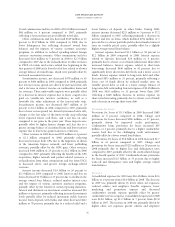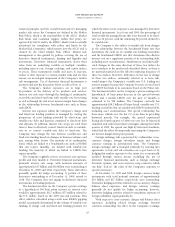American Express 2009 Annual Report Download - page 40
Download and view the complete annual report
Please find page 40 of the 2009 American Express annual report below. You can navigate through the pages in the report by either clicking on the pages listed below, or by using the keyword search tool below to find specific information within the annual report.2009 FINANCIAL REVIEW
AMERICAN EXPRESS COMPANY
Net cash provided by operating activities increased in 2008
compared to 2007 primarily due to the increase in non-cash
provisions for losses and deferred taxes, acquisition cost and
other, offset by the outflow of cash resulting from fluctuations
in the Company’s other assets.
Cash Flows from Investing Activities
The Company’s investing activities primarily include funding
cardmember loans and receivables, securitizations of
cardmember loans and receivables, and the Company’s
available-for-sale investment portfolio.
For the year ended December 31, 2009, increased net cash
used in investing activities of $6.8 billion compared to net
cash provided by investing activities of $7.6 billion in 2008,
due to lower proceeds from cardmember loan securitizations
primarily due to a decrease in maturities and redemptions of
investments, and an increase in restricted cash required for
related securitization activities.
In 2008, net cash used in investing activities increased
from 2007 primarily due to net decreases in cardmember
receivables and loans balances and cash provided by the sale
of investments attributable to discontinued operations offset
by cash used for acquisitions.
Cash Flows from Financing Activities
The Company’s financing activities primarily include issuing
and repaying debt, taking customer deposits, paying
dividends, and repurchasing its common and preferred
shares.
In 2009, net cash used in financing activities of $4.6 billion
decreased compared to 2008, primarily due to an increase in
customer deposits in 2009 and a reduction in cash used in
financing activities attributable to discontinued operations in
2008.
In 2008, net cash used in financing activities increased
compared to 2007, primarily due to net repayments of debt
and the net cash used in financing activities attributable to
discontinued operations, partially offset by a decrease in the
repurchase of American Express common shares from 2007.
CERTAIN LEGISLATIVE, REGULATORY AND OTHER
DEVELOPMENTS
As a participant in the financial services industry, the
Company is subject to a wide array of regulations applicable
to its businesses. The Company is a bank holding company
and is subject to the supervision of the Federal Reserve. As
such, the Company is subject to the Federal Reserve’s
regulations and policies, including its regulatory capital
requirements. In addition, the extreme disruptions in the
capital markets since mid-2007 and the resulting instability
and failure of numerous financial institutions have led to a
number of proposals for changes in the financial services
industry, including significant additional regulation and the
potential formation of additional regulatory bodies. To that
end, in the summer of 2009 legislation proposing significant
structural reforms to the financial services industry was
introduced in the U.S. Congress. Among other things, the
legislation proposes the establishment of a Consumer
Financial Protection Agency, which would have broad
authority to regulate providers of credit, savings, payment and
other consumer financial products and services. Additional
legislative proposals also call for substantive regulation across
the financial services industry, such as new requirements for
the securitization market, including requiring sponsors of
securitizations to retain a material economic interest in the
credit risk associated with the underlying securitization.
Legislative and regulatory changes could impact the
profitability of the Company’s business activities, require the
Company to change certain of its business practices and
expose it to additional costs (including increased compliance
costs).
In recent years, there has been a heightened level of
regulatory attention on banks and the payments industry in
many countries. In May 2009, the U.S. Congress passed, and
the President of the United States signed into law, legislation
to fundamentally reform credit card billing practices, pricing
and disclosure requirements. This legislation accelerated the
effective date and expanded the scope of amendments to the
rules regarding Unfair or Deceptive Acts or Practices (UDAP)
and Truth in Lending Act that restrict certain credit and
charge card practices and require expanded disclosures to
consumers, which were adopted in December 2008 by federal
bank regulators in the United States. Together, the legislation
and the regulatory amendments, portions of which became
effective commencing August 2009, include, among other
matters, rules relating to the imposition by card issuers of
interest rate increases on outstanding balances and the
allocation of payments in respect of outstanding balances with
different interest rates. The Company is undertaking various
actions to mitigate the impact of the legislation and the
amendments on its business and operations. In the event any
actions undertaken by the Company to offset their impact are
not effective, the legislation and amendments will likely have a
material adverse effect on the Company’s results of
operations.
The credit and charge card industry also faces continuing
scrutiny in connection with the fees merchants are charged to
accept cards. Although investigations into the way bankcard
network members collectively set the “interchange” (that is,
the fee paid by the bankcard merchant acquirer to the card
issuing bank in “four party” payment networks, like Visa and
MasterCard) had largely been a subject of regulators outside
the United States, legislation has been introduced in Congress
designed to give merchants antitrust immunity to negotiate
interchange collectively with card networks and to regulate
certain card network practices. Although, unlike the Visa and
38
























